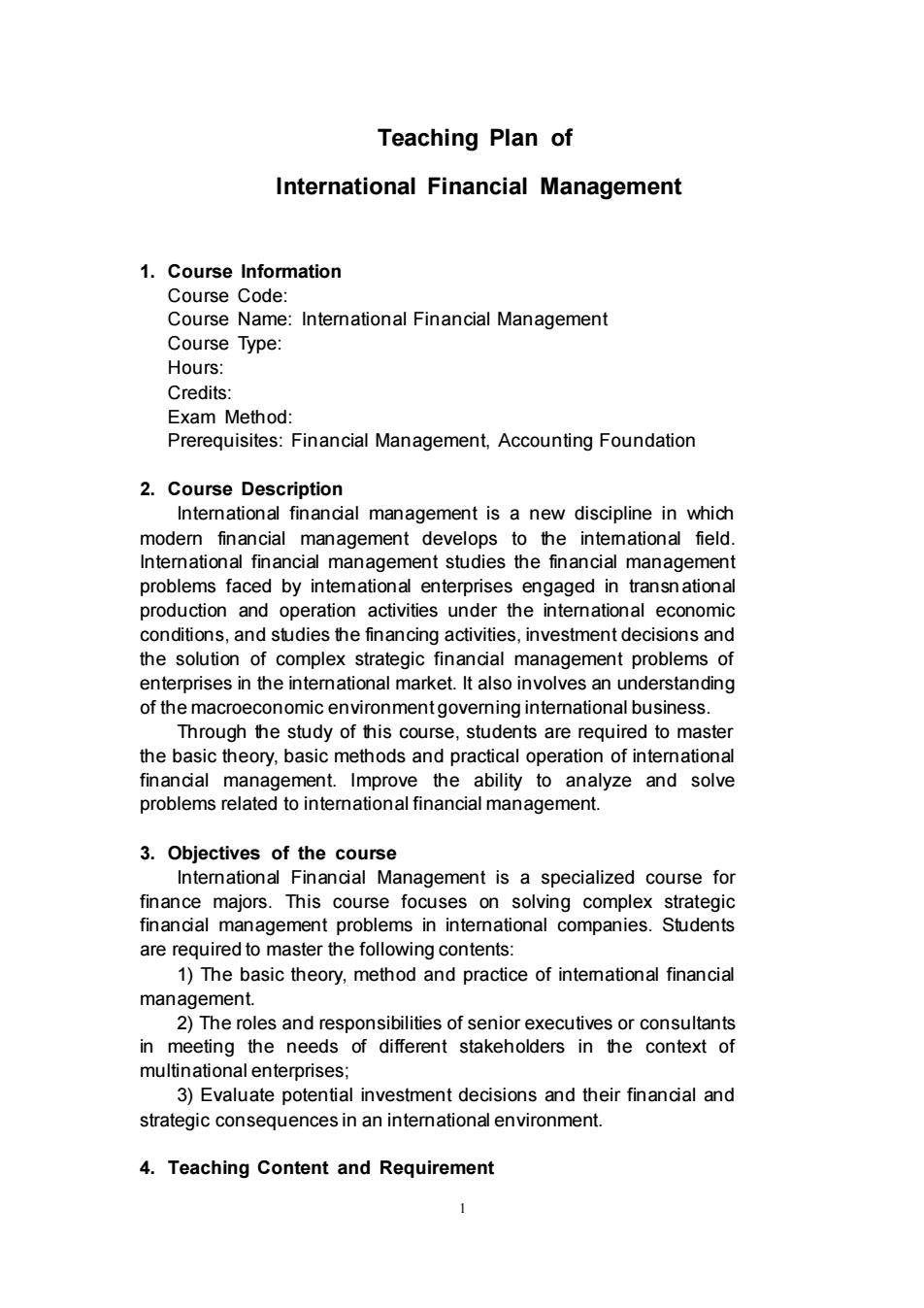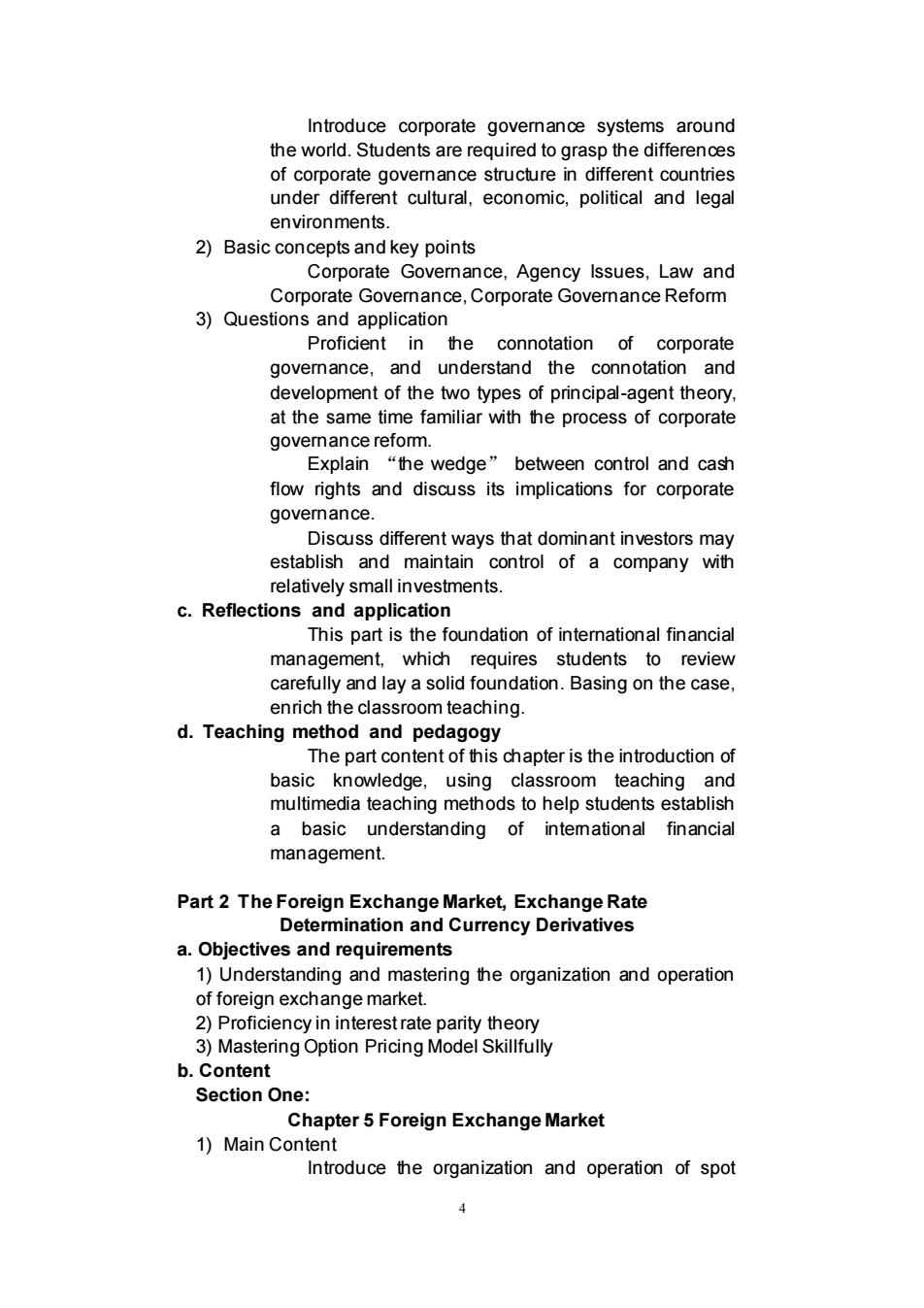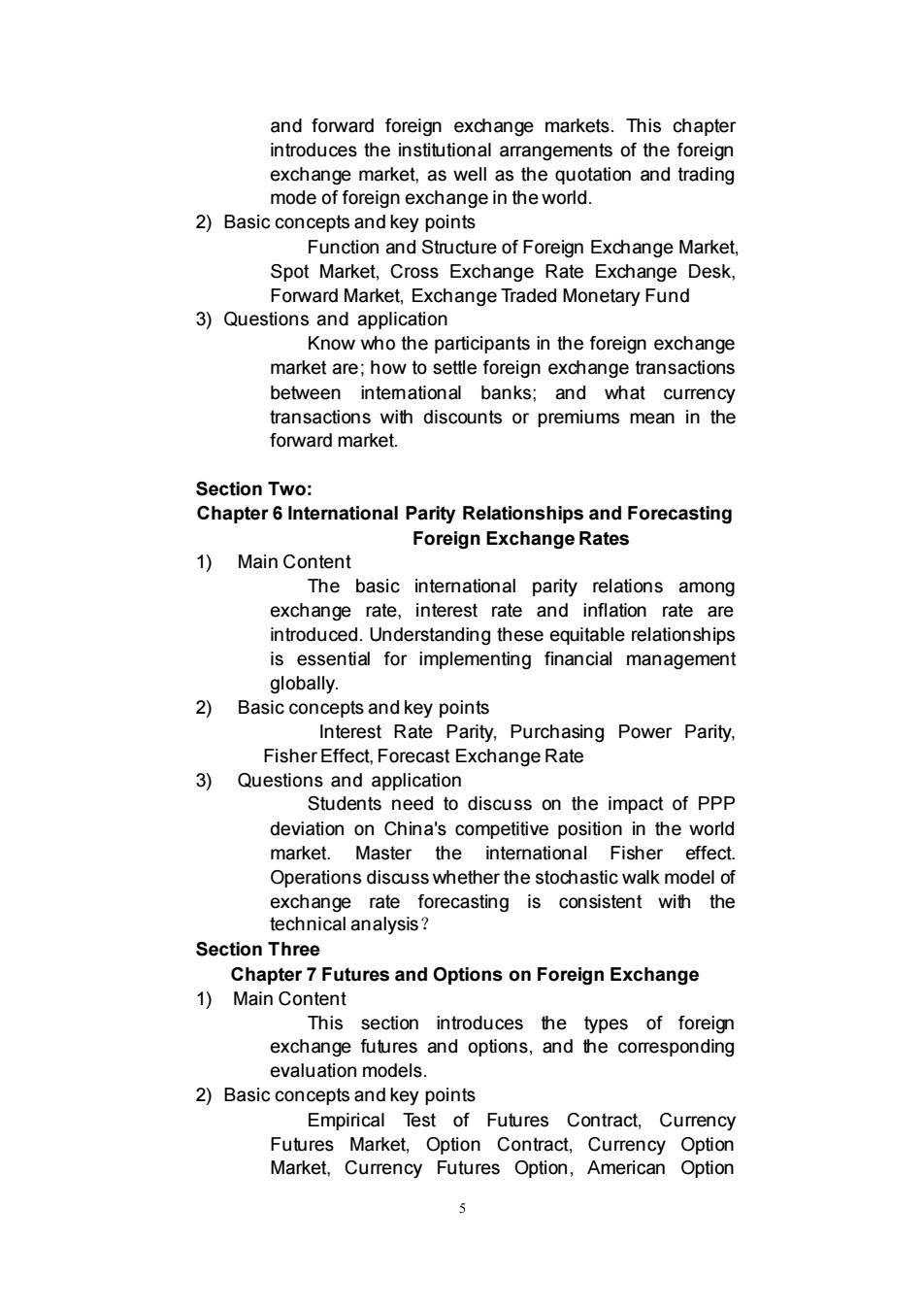
Teaching Plan of International Financial Management 1.Course Information Course Code: Course Name:Intemational Financial Management Course Type: Hours: Credits: Exam Method: Prerequisites:Financial Management,Accounting Foundation 2.Course Description International financial management is a new discipline in which fina ial management de velo the intemational field. Intemational financial management studies the financial managemen problems faced by intemational enterprises engaged in transn ational production and operation activities under the intemnational economic conditions.and studies the financing activities,investment decisions and the solution of comp plex strategic financial man gement problems of enterprises in the intemational market.It also involves an understanding of the macroeconomic environment goveming international business. Through the study of this course,students are required to master the basic theory,basic methods and practical operation of intemational financial management.Improve the ability to analyze and solve problems related to intemational financial management 3.Objectives of the course International Financial Management is a specialized course for finance majors.This course focuses on solving complex strategic financial management problems in inter ational companies.Studer ts are required to master the following contents 1)The basic theory,method and practice of intemational financial management. 2)The roles and responsibilities of senior executives or consultants in meeting the needs of different stakeholders in the context of multinatio nal enterprises 3)Evaluate potential investment decisions and their financial and strategic consequences in an international environment. 4.Teaching Content and Requirement
1 Teaching Plan of International Financial Management 1. Course Information Course Code: Course Name: International Financial Management Course Type: Hours: Credits: Exam Method: Prerequisites: Financial Management, Accounting Foundation 2. Course Description International financial management is a new discipline in which modern financial management develops to the international field. International financial management studies the financial management problems faced by international enterprises engaged in transnational production and operation activities under the international economic conditions, and studies the financing activities, investment decisions and the solution of complex strategic financial management problems of enterprises in the international market. It also involves an understanding of the macroeconomic environment governing international business. Through the study of this course, students are required to master the basic theory, basic methods and practical operation of international financial management. Improve the ability to analyze and solve problems related to international financial management. 3. Objectives of the course International Financial Management is a specialized course for finance majors. This course focuses on solving complex strategic financial management problems in international companies. Students are required to master the following contents: 1) The basic theory, method and practice of international financial management. 2) The roles and responsibilities of senior executives or consultants in meeting the needs of different stakeholders in the context of multinational enterprises; 3) Evaluate potential investment decisions and their financial and strategic consequences in an international environment. 4. Teaching Content and Requirement

Part 1 Foundations of International Financial Management ves and req irements 1)Unde standing and mastering the development of transn ationa corporations and the importance of intemnational financial management 2)Understandina and masterina the evolution of the international monetary system and the European monetary system g and Mas ring Balance of Payments Statement and B nce of Payments Theory b.Content Section One: Chapter 1 Globalization and the Multinational Firm 1)Main Content his section introduces the general situation of intemational finandal management. expounds the importance of intemnational financial research,and distinguishes the differences between intemational finance and domestic finance 2)Basic concepts and key points The characteristics of international financial management,the objectives of international financial management,Main Trends and Development of World Economic Globalization 3)Questions application differences between intemationa finance and domestic finance,understand and maste the main trends and development of world economic on the basis of understanding the intemational background Why is it important to study intemational financial management? How is international financial management different from domestic financial management?Discuss the maior trends that have iled in inte usiness during the st two How is a country s economic well- eing enhanced through free intemational trade in goods and services? Section Two: Chapter 2 International Monetary System 1)Main Content This section introduces various intemational monetary systems in which the world economy operates
2 Part 1 Foundations of International Financial Management a. Objectives and requirements 1) Understanding and mastering the development of transnational corporations and the importance of international financial management 2) Understanding and mastering the evolution of the international monetary system and the European monetary system 3) Understanding and Mastering Balance of Payments Statement and Balance of Payments Theory b. Content Section One: Chapter 1 Globalization and the Multinational Firm 1) Main Content This section introduces the general situation of international financial management, expounds the importance of international financial research, and distinguishes the differences between international finance and domestic finance. 2) Basic concepts and key points The characteristics of international financial management, the objectives of international financial management, Main Trends and Development of World Economic Globalization 3) Questions and application Understand the differences between international finance and domestic finance,understand and master the main trends and development of world economic globalization, and grasp the international financial management objectives of different countries on the basis of understanding the international background. Why is it important to study international financial management? How is international financial management different from domestic financial management? Discuss the major trends that have prevailed in international business during the last two decades. How is a country’s economic well-being enhanced through free international trade in goods and services? Section Two: Chapter 2 International Monetary System 1) Main Content This section introduces various international monetary systems in which the world economy operates

in different periods.This section traces the historical development the world's ational monetary system from the beginning of the 19th century to the present,as well as the European Monetary Union. 2)Basic concepts and key points Evolution of International Monetary System Monetary System. Rate Arrangement European Monetary System,E uro and European Monetary Union,Mexican Peso Cri sis,Asiar Currency Crisis,Argentine Peso Crisis,Fixed Exchange Rate System and Elastic Exchange Rate System 3)Questions and application Underst ding the evolution of the intemational monetary system,mastering the arrangement of the current exchange rate system,explaining how to construct SDR,and explaining the arrangement and operation of the European Monetary System(EMS). Explain mechar balance-of-payment under the gold standard. Discuss the advantages and disadvantages of the gold standard. What were the main objectives of the Bretton Woods syster Section Three: Chapter 3 Balance of Payments 1)Main Content This section introduces the relevant theories of balance of payments, recognizes the nce payments table,and introduces the trends of balance of payments in major countries. 2)Basic concepts and key points Balance of Payments Accounting Balance of Payments Accounts,Ba a Balance of Payments Trends of Major Countries 3)Questions and application Explain how to calculate the total balance of payments and discuss its significance? Describe the status of balance of payments and discuss its mpa under fixe ed and ating exchange rate regimes Section Four Chapter 4 Corporate Governance around the World 1)Main Content
3 in different periods. This section traces the historical development of the world's international monetary system from the beginning of the 19th century to the present, as well as the European Monetary Union. 2) Basic concepts and key points Evolution of International Monetary System, Monetary System, Current Exchange Rate Arrangements, European Monetary System, Euro and European Monetary Union, Mexican Peso Crisis, Asian Currency Crisis, Argentine Peso Crisis, Fixed Exchange Rate System and Elastic Exchange Rate System 3) Questions and application Understanding the evolution of the international monetary system, mastering the arrangement of the current exchange rate system, explaining how to construct SDR, and explaining the arrangement and operation of the European Monetary System (EMS). Explain the mechanism that restores the balance-of-payments equilibrium when itis disturbed under the gold standard. Discuss the advantages and disadvantages of the gold standard. What were the main objectives of the Bretton Woods system? Section Three: Chapter 3 Balance of Payments 1) Main Content This section introduces the relevant theories of balance of payments, recognizes the balance of payments table, and introduces the trends of balance of payments in major countries. 2) Basic concepts and key points Balance of Payments Accounting, Balance of Payments Accounts, Balance of Payments Identification, Balance of Payments Trends of Major Countries 3) Questions and application Explain how to calculate the total balance of payments and discuss its significance? Describe the status of balance of payments and discuss its impact under fixed and floating exchange rate regimes Section Four Chapter 4 Corporate Governance around the World 1) Main Content

Introduce corporate govemnance systems around the world.Students are required to of corporate gover e structure in different countries under different cultural,economic,political and legal environments. 2)Basic concepts and key points Corporate Govemance,Agency Issues,Law and Corporate Gove Corporate ce Reform 3)Questions and atior Proficient in the connotation of corporate governance,and understand the connotation and development of the two types of principal-agent theory at the same time familiar with the process corporate govemanc Explain the wedge between control and cash flow rights and discuss its implications for corporate govemnance. Discuss diffe ent ways that dominant investors establish and maintain contro relatively small investments. c.Reflections and application This part is the foundation of intemational financial management,which requires students to review carefully and lay a solid fo tion.Basing or the case enrich the classroom teaching. d.Teaching method and pedagogy The part content of this chapter is the introduction of basic knowledge. multimedia teaching methods to help studer stablish a basic understanding of intemationa financial management. Part 2 The Foreign Exchange Market,Exchange Rate Determination and Currency Derivatives a.Objectives and requireme 1)Understanding and mastering the organization and operation of foreign exchange market. 2)Proficiency in interest rate parity theory 3)Mastering Option Pricing Model Skillfully b.Content Section One Chapter 5 Foreign Exchange Market 1)Main Content Introduce the organization and operation of spot
4 Introduce corporate governance systems around the world. Students are required to grasp the differences of corporate governance structure in different countries under different cultural, economic, political and legal environments. 2) Basic concepts and key points Corporate Governance, Agency Issues, Law and Corporate Governance, Corporate Governance Reform 3) Questions and application Proficient in the connotation of corporate governance, and understand the connotation and development of the two types of principal-agent theory, at the same time familiar with the process of corporate governance reform. Explain “the wedge” between control and cash flow rights and discuss its implications for corporate governance. Discuss different ways that dominant investors may establish and maintain control of a company with relatively small investments. c. Reflections and application This part is the foundation of international financial management, which requires students to review carefully and lay a solid foundation. Basing on the case, enrich the classroom teaching. d. Teaching method and pedagogy The part content of this chapter is the introduction of basic knowledge, using classroom teaching and multimedia teaching methods to help students establish a basic understanding of international financial management. Part 2 The Foreign Exchange Market, Exchange Rate Determination and Currency Derivatives a. Objectives and requirements 1) Understanding and mastering the organization and operation of foreign exchange market. 2) Proficiency in interest rate parity theory 3) Mastering Option Pricing Model Skillfully b. Content Section One: Chapter 5 Foreign Exchange Market 1) Main Content Introduce the organization and operation of spot

and forward foreign exchange markets.This chapter introduces the institutional foreign exchange market.as well as the quotation and trading mode of foreign exchange in the world. 2)Basic concepts and key points Function and Structure of Foreign Exchange Market Spot Market,Cross Exchange Rate Exo change Desk Forward Market,Exchange Traded Monetary Fund 3)Questions and application Know who the participants in the foreign exchange market are;how to settle foreign exchange transactions between intemational banks:and what currency transactions with discounts or premiums mean in the forward market Section Two: Chapter 6 International Parity Relationships and Forecasting Foreign Exchange Rates 1)Main Content The basic intemational parity relations among exchange rate,interest rate and inflation rate are introduced.Understanding these equitable relationships is essential for implementing financial management globally 2)Basic concepts and key points Interest Rate Parity,Purchasing Power Parity, Fisher Effect,Forecast Exchange Rate 3)Questions and application Students need to discuss on the impact of PPP deviation on China's competitivepositioninthe word market.Master the intemational Fisher effect Operations discuss whether the stochastic walk model of exchange rate forecasting is consistent with the technical analysis? Section Thre Chapter 7 Futures and Options on Foreign Exchange 1)Main Content This section introduces the types of foreigr exchange futures and options and the esponding evaluatio els 2)Basic concepts and key points Empirical Test of Futures Contract,Currency Futures Market,Option Contract,Currency Option Market,Currency Futures Option,American Option
5 and forward foreign exchange markets. This chapter introduces the institutional arrangements of the foreign exchange market, as well as the quotation and trading mode of foreign exchange in the world. 2) Basic concepts and key points Function and Structure of Foreign Exchange Market, Spot Market, Cross Exchange Rate Exchange Desk, Forward Market, Exchange Traded Monetary Fund 3) Questions and application Know who the participants in the foreign exchange market are; how to settle foreign exchange transactions between international banks; and what currency transactions with discounts or premiums mean in the forward market. Section Two: Chapter 6 International Parity Relationships and Forecasting Foreign Exchange Rates 1) Main Content The basic international parity relations among exchange rate, interest rate and inflation rate are introduced. Understanding these equitable relationships is essential for implementing financial management globally. 2) Basic concepts and key points Interest Rate Parity, Purchasing Power Parity, Fisher Effect, Forecast Exchange Rate 3) Questions and application Students need to discuss on the impact of PPP deviation on China's competitive position in the world market. Master the international Fisher effect. Operations discuss whether the stochastic walk model of exchange rate forecasting is consistent with the technical analysis? Section Three Chapter 7 Futures and Options on Foreign Exchange 1) Main Content This section introduces the types of foreign exchange futures and options, and the corresponding evaluation models. 2) Basic concepts and key points Empirical Test of Futures Contract, Currency Futures Market, Option Contract, Currency Option Market, Currency Futures Option, American Option